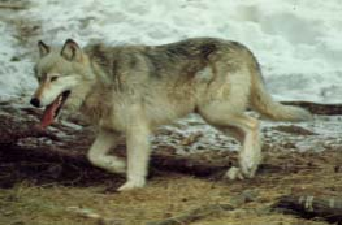Travel Reference
In-Depth Information
The smallest dog-like animal in Yellowstone is the
red fox
(Vulpes vulpes),
which weighs
about 10 to 12 pounds (4.5-5.5 kg). Some “red” foxes have white-tipped black hairs, giving
them a silvery appearance.
A mature
gray wolf
(Canis lupus irremotus),
also called a timber wolf, is likely to weigh two
or three times as much as a coyote. It has a more massive body and a less pointed snout and
ears. A wolf's tracks are the size of a large dog's, and its color may be anywhere from nearly
white to black. You may see wolves along the Northeast Entrance Road, particularly early and
late in the day.
Gray wolf
he Howl of the Wolf
For more than 60 years the howl of the wolf was silenced in Yellowstone. As settlers
moved into the U.S. West, wolves killed their cattle and sheep, so killing wolves was every-
one's civic duty. The government paid for wolf pelts; trappers baited buffalo carcasses with
strychnine and turned in thousands of pelts. In Yellowstone, official policy condoned ex-
termination of the wolf until 1926.
Finally things began to turn around for the wolves. After extensive debate and plan-
ning, 14 wolves were trapped in Alberta, Canada in midwinter 1995 and 17 in British
Columbia in 1996. They were brought to the park, kept for a few weeks in specially con-
structed pens, and then released. A 1997 experimental release of ten young wolves from a
northwestern Montana pack that had been preying on livestock was not as successful, since
only two of them survived into adulthood. But most of the originally relocated wolves have
thrived. They have dispersed into neighboring parts of the Greater Yellowstone Ecosystem
and formed new packs. Early winter 2012-13 saw nine wolf packs in the park and 86 indi-
vidual wolves, including some considered “border” wolves.

